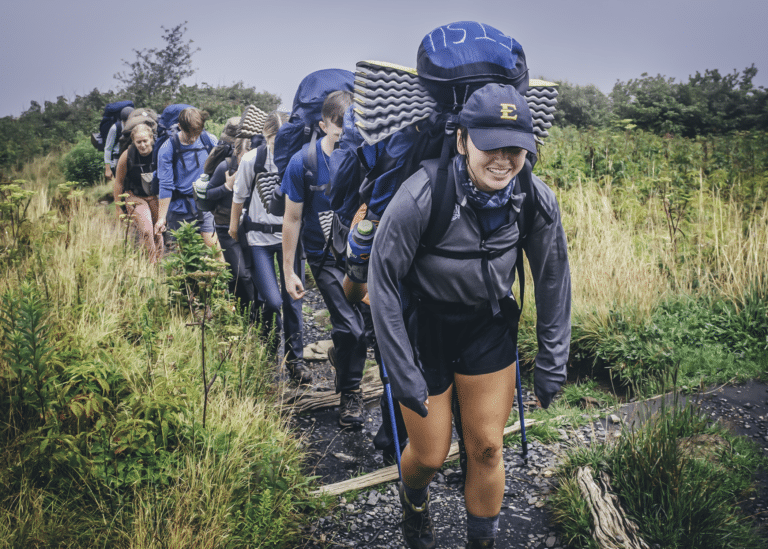We outdoorsy folks tend to feel smugly superior to others when it comes to our eco-conscious lifestyles. Who among us doesn’t stand a little taller knowing our neighbor owns two SUVs and a Sam’s Club card while we drive a Prius and shop at the farmer’s market? Even our sports are green. While our neighbor heads off to the golf course, we hit the trails and crags. And what’s more environmentally friendly than human powered outdoor sports?
In the spirit of one-up-man-ship, we at BRO decided to investigate the actual environmental impact of our favorite outdoor pastimes. Which is the most environmentally friendly? With three key factors in mind-resource extraction, gear production, and ecological impact-BRO uncovered the environmental shortcomings of five core outdoor sports to determine the winner of the Greenest Sport Award. The results might surprise you.
BIKING
The bike is the darling of the environmental movement, and for good reason. If everyone stopped driving and started biking, we’d cut our personal carbon emissions by 70 percent. But as it turns out, biking isn’t without its own eco-issues.
Mountain bikes can wreak excessive damage to trail systems. If you’ve visited a popular trail after a heavy rain, you’ve seen the environmental impacts firsthand: rutted trails, washouts, and erosion, to name a few.
But the most serious environmental degradation from biking comes from the bike itself. Since the mid ‘80s, when Cannondale introduced the first aluminum frame, aluminum has been the go-to material for most bike manufacturers. Some high end racing bike models incorporate carbon composite or titanium-both of which haveeven more severe environmental concerns. But the majority of bikes on the roads and trails today are forged from aluminum. According to the EPA, wastes from extracting metal resources exceed all other wastes generated in the U.S. economic cycle, and waste muds created specifically by the extraction of aluminum may contain low levels of radioactivity. What’s more, the furnaces used for melting aluminum result in high energy costs, even more waste production, and the emission of greenhouse gases and nitrogen oxide emissions, according to research done at the University of Kentucky. (Kentucky has the highest concentration of aluminum companies in the world.)
While aluminum is one of the most recyclable materials, bike frames have to be made from virgin aluminum because of its structural properties. Even then, the end product is very fragile, making the bicycle frame a very impermanent thing.
Add to this the petroleum costs of the rubber used for tires and components-and of course the mandatory plastic helmet-and the energy costs of manufacturing a bike often exceed the energy saviungs in riding it.
CLIMBING
Most environmental criticism surrounding rock climbing focuses on ecosystem impact. The fixed bolts used in sport climbing are a particular concern. Bolts are permanent devices drilled into a rock face with lightweight electric drills and some National Parks like Joshua Tree have regulated bolt use, allowing it only in certain areas. Other forests and wilderness areas have sought to ban bolt use altogether.
A 2002 study published in “Conservation Biology” suggests that environmental impact of climbing goes further than excessive bolting. Cliffs popular with climbers had much less diverse vegetation: the climbed faces monitored in the study had only four percent of the vascular plant species of unclimbed cliffs.
A subsequent study focusing on rock faces in Wisconsin showed climbing directly affects land snail populations that usually thrive on America’s cliffs.
In the Southeast, peregrine falcons have been particularly affected by climbing. The endangered peregrine is particularly sensitive to human disturbance, and climbing within the territory of a breeding pair could result in nest abandonment. Negative falcon-human interactions have resulted in several climbing closures across the Southeast, including parts of popular Looking Glass Rock and Linville Gorge.
While many recreational activities can be spread out over thousands of miles of trails and rivers, rock climbers are often forced to climb the same areas over and over because of a widespread lack of legal access. The more a cliff is climbed, the more damage is done to its ecosystem.
HIKING/BACKPACKING
Many hikers hit the trail to escape the problems of urban industry and toxic waste. Unfortunately, they're toting many of those problems with them on their backs.
“Every backpack or tent depletes our natural resources and creates unnecessary energy waste,” says Sarah Roberts of The New Dream, a non-profit concerned with over consumption. “A lot of hiking gear is made from PVC [polyvinyl chloride], which isn’t environmentally friendly,”
Americans represent five percent of the population but consume 25 percent of the world’s resources, and hiking may as well be the poster child for America’s overconsumption habit. While the research and development departments of gear companies constantly outdo themselves and their competitors, flooding the market with new and improved products every season, outdoor enthusiasts like gobble them up at an alarming rate. Most of those products, particularly tents, backpacks, and sleeping pads, are made with PVC, the most environmentally harmful plastic on the planet. The life cycle of a PVC product like a backpack also includes mercury emissions, the use of two known cancer-causing substances during production, and the release of toxic additives that escape from the product itself. Think about that the next time you use your pack as a pillow. Several European governments have already restricted its use; here in the States, PVC is responsible for billions of dollars in Superfund site cleanups.
Then there's the ecological impact from heavily concentrated hiking use. The majority of hikers repeatedly visit a small percentage of the trail systems, concentrating their use on specific areas like Old Rag in Virginia or Abrams Falls Trail in the Great Smoky Mountains National Park. Concentrating recreational use in one area intensifies the negative impacts of that use on the environment, including vegetation degredation, wildlife impacts, and erosion.
TRAIL RUNNING
While gear obsession plagues other outdoor sports, runners usually take a more minimalist approach. Strip the sport down to its bare essentials and all you need is a pair of short shorts and some shoes. Unfortunately, those shoes are some of the most environmentally and socially irresponsible products on the planet. From the rubber soles (petroleum based) to the synthetic uppers (petroleum based) to the foam mid-sole (petroleum based) to the toxic glue that keeps it all together (petroleum based) to the overseas sweatshop practices behind much of the production, the running shoe is the Napalm of outdoor gear.
Trails may be more eco-friendly than roads, but even trail runners have significant ecological impacts. Foot traffic through wild corridors can adverse alter animal behavior and reproduction while compromising habitat security, according to the 1995 study from the Center for Resource Economics, “Wildlife and Recreationists.” While runners and hikers aren’t directly threatening wildlife like hunters, they do startle the forest’s natural inhabitants, inadvertently flushing various species from their nests making them and their offspring more susceptible to legitimate prey. Many man-made trails can also fragment wildlife corridors, and despite the best intentions of runners, overused trails can be littered with used gel packets and energy bar wrappers, and trailside bathroom breaks can spread pathogens into pristine forests and waterways.
PADDLING
The most significant environmental impact of paddling can be summed up in one word: oil. The majority of kayaks and canoes are made from polyethylene, one of the lightest and most durable plastics available. Like all plastic, however, polyethylene is 100 percent petroleum based. It’s also non-biodegradable, toxic, and non-recyclable.
The plastic found in kayaks is a double whammy on our oil supplies. Petroleum is the raw material used for manufacturing and transportation, and petroleum is also necessary for production when the raw material is turned into plastic. According to a United Kingdom’s Environmental Agency report on world plastic consumption, eight percent of the world’s annual oil production is used for manufacturing plastic.
On top of oil dependence, the harmful by-products created during the production process of polyethylene are also alarming. In 1992 alone, the plastics industry produced 567 million pounds of toxic waste according to the EPA.
AND THE AWARD GOES TO…
It’s a three-way tie for the Greenest Sport Award: naked, barefoot trail running; open water swimming (no plastic goggles or synthetic Speedos, please), or bamboo-board surfing (see sidebar). Human-powered watersports generally have less wildlife impact, and there are no permanent trails required.
Ultimately, however, not even nude watersports are free from environmental harm. Truth is, there is no such thing as a perfectly green sport. But don’t get depressed. There are things we can do to make our sports greener (see sidebar), and the physical and emotional health gains from these activities are worth the relatively low environmental impact.
“Each of these sports gets more people out in the forests, and any time that happens you’re going to get more people protecting the resources,” says Bob Gale, an ecologist for the Western North Carolina Alliance. “All these activities raise awareness and appreciation and inspire people to do more for the environment.”
So play on. After all, it could be worse: we could all be golfers.
Green Waves
Take your green sport to the next level of eco-friendliness with these innovative trends.
Recycled Kicks
Old running shoes may be stanky but there’s no reason to throw them away. In 1993, Nike created an international shoe recycling program called Reuse-a-Shoe, which turns worn out sneakers into turf soccer fields, bouncy basketball courts and tracks. Since the program’s inception, Nike has kept more than 15 million toxic shoes out of landfills. www.nikereuseashoe.com.
A Better Bike
They use bamboo as scaffolding in Asia, so why not build bike frames out of it every where else? World renown bike designer Craig Calfee is now marketing a bamboo bike so slick you can race it. www.calfeedesign.com. Or learn to build your own bike at www.woodenbikes.com.
Eco Surfboards
Patagonia has created a line of boards using a biodegradable polystyrene foam center and epoxy resins that release 75 percent fewer volatile organic chemicals into the air during production than the traditional resins. And a small Australian company has gone a step further by wrapping sheets of bamboo around the new polystyrene/epoxy core. The bamboo is twice as strong as fiberglass and non-toxic at all levels. www.pointblanks.com, www.bamboosurfboards.com.







